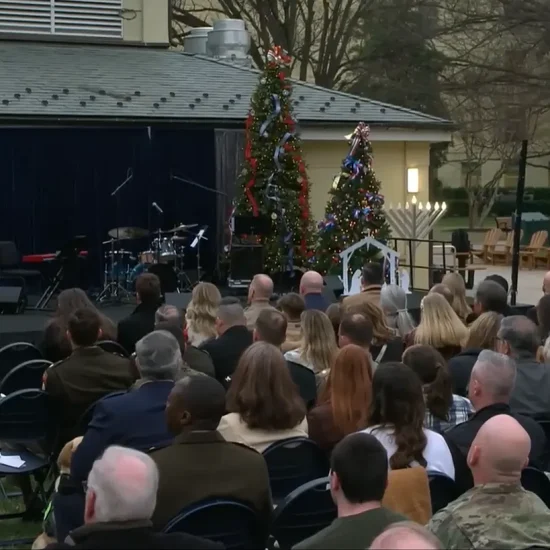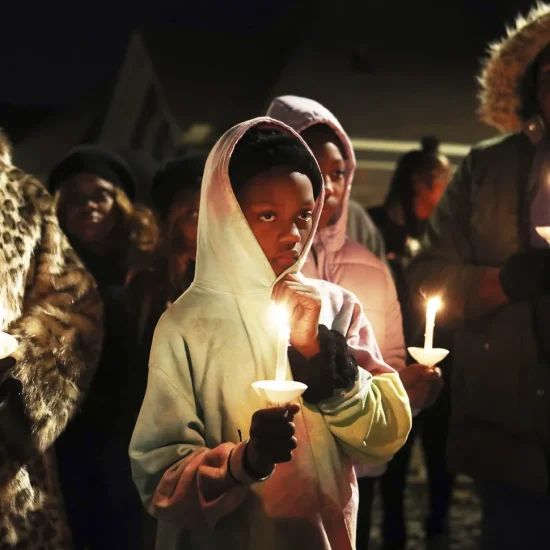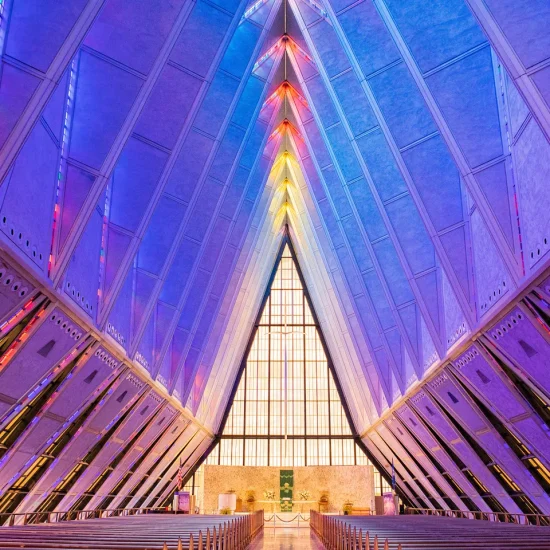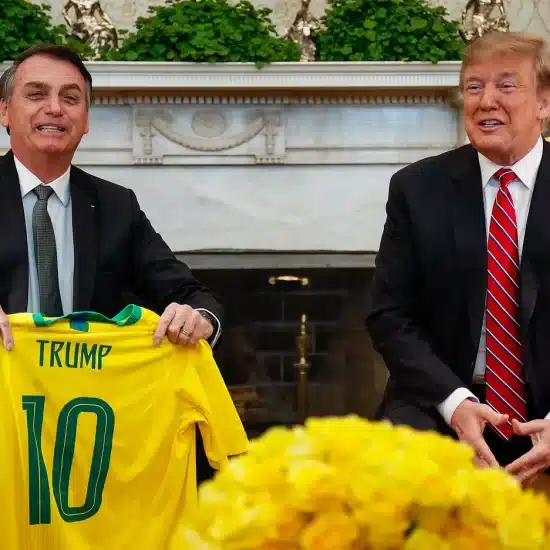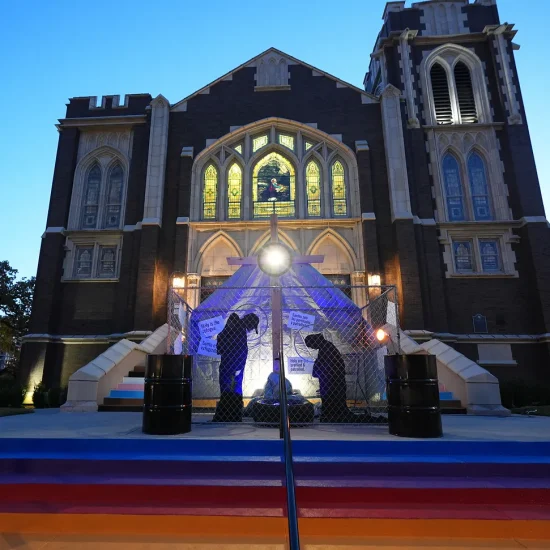
(RNS) — Clergy representing over 30 Pennsylvania religious groups rallied last Thursday (April 3) outside of Philadelphia’s U.S. Immigration and Customs Enforcement Office against President Donald Trump’s order allowing immigration arrests at houses of worship.
To make their point, the clergy built an interfaith altar at ICE’s doorstep and offered to break bread with ICE agents, appealing to their shared humanity and values.
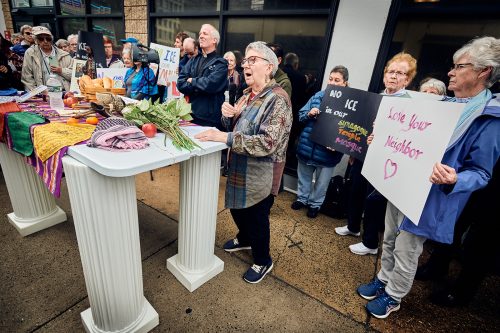
Rabbi Linda Holtzman, of Tikkun Olam Chavurah, addresses a protest outside the offices of U.S. Immigration and Customs Enforcement, Thursday, April 3, 2025, in Philadelphia. (Photo by Rodney Atienza/New Sanctuary Movement)
The clergy are part of an interfaith immigrant advocacy network called New Sanctuary Movement of Philadelphia, representing Jewish, Mennonite, Catholic, Baptist, and Unitarian congregations, among other faiths. They were joined by nearly 100 people.
“As Trump attempts to take away every safe space, we as the faith community stand in our moral authority to confront injustice, reclaim our sacred spaces and lift up the power of transformative love everywhere — even to the ICE office and ICE agents,” the group said on social media.
The structure for the altar was provided by Sisters of Saint Joseph’s Philadelphia parish, and it featured items of spiritual significance from various religious and cultural traditions. As attendees placed items like crosses, statues, flowers, rosaries, and fruits at the altar, they were led in song by Rabbi Linda Holtzman of Philadelphia’s Tikkun Olam Chavurah, a Jewish social justice group. Holtzman placed a shofar, or a ram’s horn used for Jewish ceremonies, at the altar.
The protest was held in response to the executive order Trump signed his first day in office in January, allowing for ICE arrests at sensitive locations, including houses of worship. The order overturned protections laid out in a 2011 memo discouraging ICE arrests, interviews, and searches in locations including hospitals, public religious ceremonies like weddings or funerals, schools, and houses of worship, barring “exigent circumstances.”
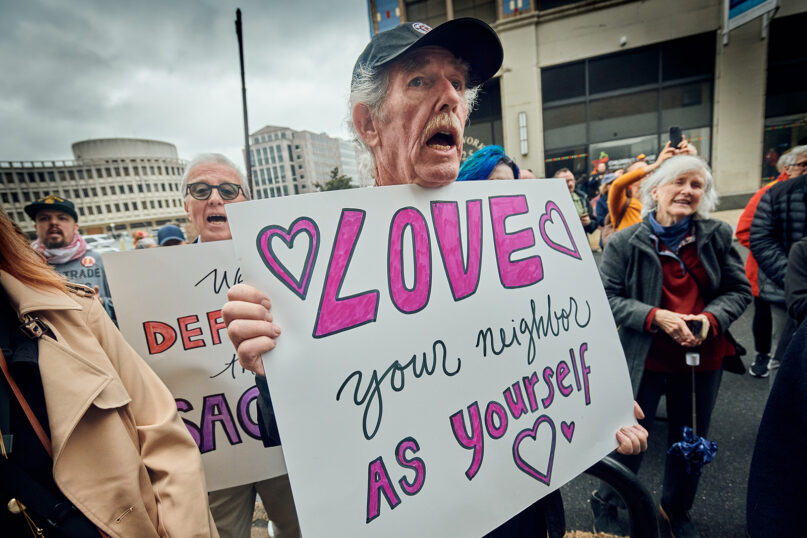
People protest outside the offices of U.S. Immigration and Customs Enforcement, Thursday, April 3, 2025, in Philadelphia. (Photo by Rodney Atienza/New Sanctuary Movement)
Trump’s executive order incited lawsuits from religious organizations, which argued the order infringes on their First Amendment right to freedom of religious exercise. The policy change has resulted in at least one immigration arrest at a church in January, and religious service attendance among immigrants has decreased, including for those with legal status and U.S. citizenship, RNS previously reported.
New Sanctuary Movement of Philadelphia, which was formed in 2007 by clergy and community organizers, has long advocated for immigrants in Philadelphia and surrounding areas. Its work has involved providing houses of worship with “know your rights” trainings and advocating for policy changes.
NSM’s organizers said the executive order opens the door for inhumane and unconstitutional invasions of sacred spaces.
“With the rescinding of the sensitive locations memo, it really feels like they are trying to take away any remaining safe space in people’s lives,” said Peter Pedemonti, the movement’s co-founder and co-director. “There’s something about the targeting of faith communities that feels especially cruel. To try and cut somebody off from their spiritual home and their community right now, there’s a cold-heartedness or hard-heartedness to it.”
The group of clergy leading the protest symbolically chose to build the interfaith altar in front of Philadelphia’s ICE office because, in the Rev. Christopher Neilson’s words, “In the biblical tradition, God is everywhere. He cannot be contained in buildings. We live and move and have our being in God.”
Neilson, who is the founder and director of Christianity for the Living Ministries, an organization that works primarily with Philadelphia’s Caribbean community, said, “We go to ICE to say that, here is also sacred space. Here is also God’s space.”
At the altar, Holtzman led attendees in a nigun, or wordless song, whose tune was derived from Hebrew Scripture, which says, “mah norah hamakom hazeh,” translating to, “how awesome is this space.”
“While all of the clergy may see God differently, they all pretty much see God as a power that moves them toward doing what is right and what matters,” Holtzman said. “It matters that clergy, as a group, stand up and speak out. Doing so at the ICE office is doing it in a place that very desperately needs to hear a message of justice, because they are acting as unjustly as possible.”
Initially, the rally’s crowd stood on sidewalks because they did not have a permit to protest; however, as their numbers grew, the Philadelphia Police Department’s Civil Affairs Unit moved to close the street to cars, Pedemonti said.
Toward the end of the protest, attendees broke bread together in a ceremony led by the Rev. Joe Shields, a retired Catholic priest.
“This action was led by clergy, and the clergy were up front and center,” Neilson said. “It’s important for people to see the religious authorities stand up, for people to glean from (their) endorsements that ‘you are seen, you are valued and God is on your side.’”
Neilson added, “The imagery was powerful in the sense of its plurality, and was singularly powerful in terms of sharing the bread together.”
The protest stood in defiance of ICE policies but also sought to extend an olive branch to ICE officers in an appeal to their humanity, Pedemonti said. ICE and other law enforcement officers who watched the protest were invited to break bread with the clergy.
Pedemonti said that while the ICE officers politely declined the bread, it was important to extend the offer as directed by their shared values.
“Yes, there was defiance there because part of our prophetic tradition is to stand in defense of (immigrants), but there was also a reaching out to ICE with God’s love,” Neilson said. “As human beings, many of them are probably conflicted because they’re following orders, but they are wondering why.”

